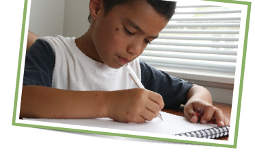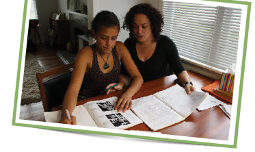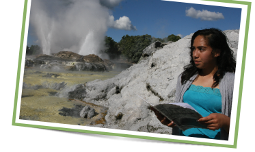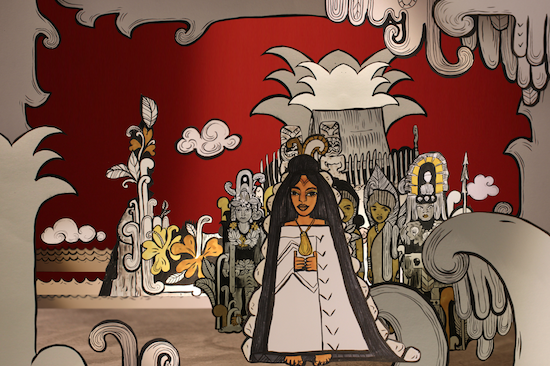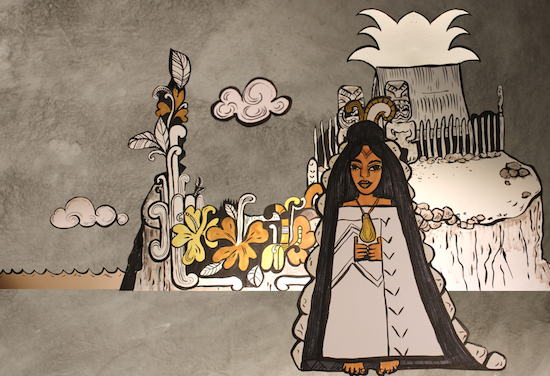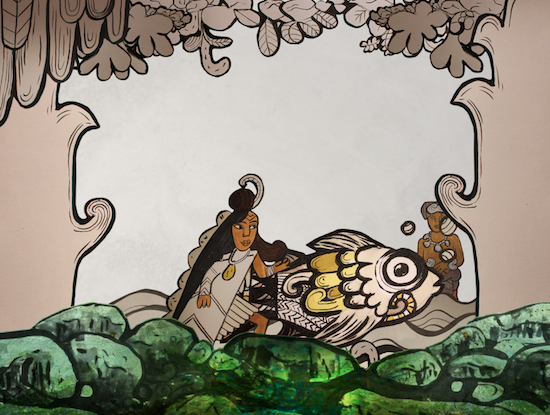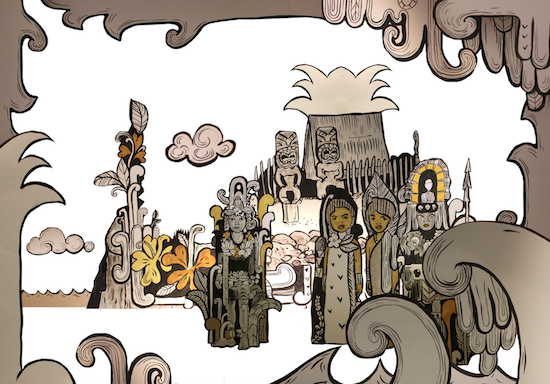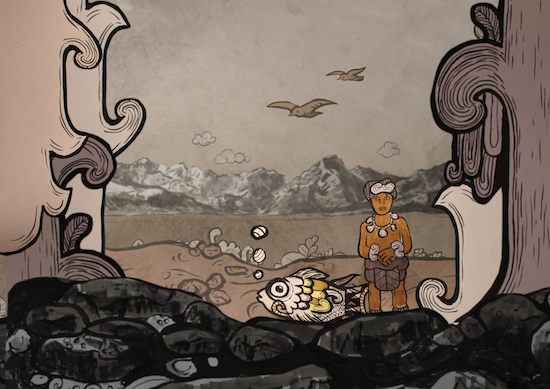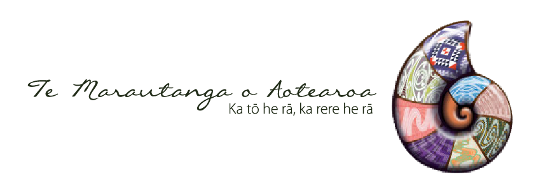Pōpō!: Level 2
Hinetūāhōanga
Te Whatu o Poutini
This unit uses the second stanza of the oriori Pōpō! as a focus for learning, and gaining a deeper understanding of the text. It links to the Reo Māori, Tikanga ā-Iwi, Hangarau and Ngā Toi learning areas, supporting teaching and learning at level 2 of Te Marautanga o Aotearoa.
The activities have been designed to create oral language opportunities – both formal and informal.
Pōpō! E tangi ana Tama ki te kai māna!
Waiho me tiki ake ki te Pouahaokai,
Hei ā mai te pakake ki uta rā
Hei waiū mō Tama!
Kia mauria mai e tō tupuna, e Uenuku!
Whakarongo! Ko te kūmara ko Parinuiterā.
Ka hikimata te tapuae o Tangaroa,
Ka whaimata te tapuae o Tangaroa.
Tangaroa! Ka haruru!
Ka noho Uru, ka noho i a Ngangana
Puta mai ki waho rā ko Te Aotū, ko Te Aohore,
Ko Hinetūāhōanga, ko Tangaroa
Ko Te Whatu o Poutini ei!
Akoranga 1
Whakarongo
Purpose
To learn the first two stanzas of the oriori Pōpō!
Learning Intentions
Students/we are learning to:
- Recite the first two stanzas of the oriori and pronounce the words correctly.
- To identify the main ideas in the second stanza of the oriori.
- Retell the main ideas in their own words.
What You Need
- Pōpō! – the animated oriori and audio track
- Data projector or interactive whiteboard
- Cushions or pillows (optional)
Watch the video for the waiata Pōpō
What You Do
Suggestion – teach first thing in the morning. The following material is designed to be spread over a number of sessions – break it up where it suits you and your students.
Listening
Akoranga ā-akomanga.
- Use the Pōpō! audio track. Ask students to close their eyes. Play the audio track and listen to the entire mōteatea.
- After listening to Pōpō! ask these questions:
What feelings did you get when you listened to this mōteatea?
- Talk about the mōteatea. Explain:
Pōpō! was composed by Enoka Te Pakaru who was Te Aitanga ā-Māhaki, from Tūranganui-a-Kiwa. It is an oriori, which is a soothing type of mōteatea, that is usually full of tribal stories. A parent or grandparent perhaps, would lull a child with stories and whakapapa. This way a child would grow up hearing and learning about these important things from a young age.
Listening and viewing
- Play Pōpō! again, but this time show the pictures that go with the text. Listen to just the first two stanzas. Between stanzas brainstorm as class the key words they remember hearing and explain meanings. Record the words.
Possible list first stanza:
– haruru
– Kūmara
– pakake
– pōpō
– Tama
– Tangaroa
– tupuna
– Uenuku
– waiū
Possible list second stanza:
– Hinetūāhōanga
– Ngangana
– Te Aohore
– Te Aotū
– Te Whatu o Poutini
– Uru
- Use the following activities to consolidate vocabulary.
– Hangman
either in pairs, small groups or as a whole class.
– Crosswords
use this link and the lists you have made as a class to create crosswords.
http://www.education.com/worksheet-generator/reading/crossword-puzzle/?gclid=CKbXjuq4wcwCFcOSvQoda4wBQw&gclsrc=aw.ds
– Word searches
use this link to create word searches from your vocabulary lists.
http://www.education.com/worksheet-generator/reading/word-search/
Understanding
-
Play the first two stanzas of Pōpō! with the images as well. Ask students to look at the pictures and listen carefully. Ask:
What do you think the stories are about?
What are some of the things you recognise? - As a class share ideas about the stories from stanzas 1 and 2.
- Discuss the oriori and explain:
The first part of Pōpō! lets us know that this mōteatea is an oriori. Even the first word gives us a clue – Pōpō!. The composer is trying to soothe the hungry baby, Tama, by telling amazing stories about food – about the magic bird Pouahaokai, about the atua Uenuku and about tupuna who returned far across the sea to Parinuiterā to fetch the kūmara.
The second stanza retells the story of Hinetūāhōanga and Poutini. The first lines explain Hinetūāhōanga’s whakapapa.
Ngahue had an incredibly beautiful pet fish which made Hinetūāhōanga very jealous – she wanted that fish! Ngahue and Poutini fled Hawaiki, making their way across the Pacific to Aotearoa. Hinetūāhōanga chased them all the way. Eventually Ngahue and Poutini arrived on the West Coast of the South Island where Ngahue found a safe hiding place in the Arahura River for Poutini. The West Coast is known as Te Tai Poutini.
Te Whatu o Poutini is also another name for pounamu, and Hinetūāhōanga was guardian of sandstone, which is the stone used for shaping pounamu.
Learning Pōpō! – the first two stanzas
Ako ā-kākā
Using the audio, or audio visual, tracks as guides learn the first two stanzas of Pōpō!. As a group recite the lines of the first stanza.
Learn the text line by line, adding a new line in when you are confident the group has embedded the previous lines. Depending on your students this may take a few sessions.
Consolidating the text
Using the first two stanzas, ask the students to storyboard their favourite part of the oriori e.g. the Pouahaokai story; the story of Hinetūāhōanga.
Explain that storyboards are pictures that are sequenced to help tell a story. They are really useful for storytelling and planning e.g. films, plays.
- Students choose a part of the text to focus on, e.g. Hinetūāhōanga.
- Brainstorm the chosen section.
– Hinetūāhōanga
– Her parents – Uru and Ngangana
– Her siblings – Te Aotū and Te Aohore
– Hawaiki
– Poutini
– Ngahue
– Tuhua
– Te Tai Poutini
– Arahura
– Huna
- Select four key ideas to show on the storyboard. For example:
Hawaiki
Ngahue and Poutini
Tuhua
Arahura
- Students fold a sheet of A4 paper into 4 sections and illustrate their main ideas in each section. Set a time limit so that students don’t spend too much time on the drawings.
- In pairs, students share their storyboards, telling their partner what is happening in each scene. Encourage students to ask questions of each other and offer feedback.
Possible Assessment Opportunities
Students can:
- Recite the first two stanzas of the oriori Pōpō!
- Identify and speak about the main ideas in the first two stanzas of Pōpō!
- Retell a part of the oriori in their own words.
Akoranga 2
The Origin of Pounamu
Purpose
To listen to the pūrākau of Hinetūāhōanga and Poutini.
Learning Intentions
Students/we are learning:
- The story of Hinetūāhōanga and Poutini.
- To retell the story in their/our own words.
What You Do
Listening and discussing
- Generate a classroom discussion about pounamu and sandstone. Write the class ideas onto a large sheet of paper for display in the classroom. Ask:
– What do we already know about pounamu and sandstone?
– Where does it come from?
– Where is it found?
– Why did our tūpuna value both these stones so much?
– What stories do you think our tūpuna have about where pounamu and sandstone come from and how they got here?
- Explain that different iwi have different stories about how pounamu and hōanga came to Aotearoa. Read this story – as told by Sir Tipene O’Regan of Ngāi Tahu. (See below or follow this link – http://www.TeAra.govt.nz/mi/pounamu/page-2)
– Introduce any words you think might be unfamiliar.
– Identify the names of people/atua/ taniwha and places.
– You could use a map of Pacific (or Aotearoa) to show the journey that Hinetūāhōanga and Poutini made.
Te Takenga mai o te Pounamu
He kōrero tā tēnā iwi, tā tēnā iwi mō te takenga mai o te pounamu.
Nā Tā Tipene O’Regan o Ngāi Tahu tēnei kōrero.
Ko Poutini te kaitiaki o te pounamu. I wehi a ia ki tērā taniwha a Whaitipū, te kaitiaki o te hōanga (sandstone). I ngā wā o mua ko te hōanga hei tapahi i te pounamu.
Ka whāia e Whaitipū a Poutini, ka rere tērā ki Tūhua – he motu kei Te Moana-a-Toi, ki reira whakamaru ai. Ka kite a Poutini i tētahi wahine purotu ki reira, ko Waitaiki, e heke iho ana ki te kaukau i te wai. Mīharo katoa a Poutini ki tōna ātaahua. Nā te kaha rawa o tōna hiahia ki te wahine rā, ka kapohia e Poutini, ka kāhakina ki tuawhenua.
Kia mōhio a Tamaāhua – te tāne a Waitaiki – kua ngaro tana wahine, ka karakia i tana karakia huri kaupapa ki te wānanga kei hea tana wahine. Kātahi ka whiua e Tamaāhua tana teka torotoro; nāwai, ka tohu te teka rā ki te takiwā kei reira a Poutini.
Kātahi ka arumia e Tamaāhua a Poutini, ā, ki Te Wai Pounamu rā anō. I te awa o Arahura ka kitea. Ka kite atu a Poutini ka mōhio, kua mau ia. Nā te nui o tana wehi ki a Whaitipū, ka hurihia e Poutini a Waitaiki hei pounamu, kia rite ki a ia ake te āhua. Kātahi ka whakatakotohia e Poutini te wahine rā ki te awa o Arahura, i te hononga mai o tētahi kōawa; nō muri ka mōhiotia ai taua kōawa, ko Waitaiki. Tatū ki ēnei rā, he wāhi nui a Arahura me Waitaiki mō te pounamu. Kāhore a Tamaāhua i kite i a Poutini, ka rere tērā kia puta ki tai.
Tatū ki ēnei rā, ko Poutini te kaitiaki o te whenua me te pounamu. Koirā te take tapaina ai taua rohe ko Te Tai Poutini.[1]
Te Pakiwaitara o Hinetūāhōanga rāua ko Pounamu
Tell the story again and then play some comprehension and memory games using the story as a focus.
-
Ko Wai Au?
Organise students into small groups. Write the names of the story’s characters on the board. A student chooses a character and the others have to guess which one they are by asking questions. You can only answer with ‘Yes’ or ‘No’. E.g.
– He tāne koe?
– He mōkai tāu?
The group that guesses your identity correctly wins.
-
Sequencing
Write one short sentence for each part of the story (between 6 and 10 sentences). Print, cut out and give a set to each group to sequence correctly based on their collective understanding of the story. Have each group read out their completed mini-stories to the class. -
Hangman or Word Scramble
Play the simple games of Hangman or Word Scramble using place names and tupuna, taniwha and atua names.
Possible Assessment Opportunities
Students can:
- Correctly sequence the story of Hinetūāhōanga and Poutini.
- Identify on a map, the places named in the story of Hinetūāhōanga and Poutini.
Akoranga 3
Whakapapa
Purpose
To investigate whakapapa and how Māori order and classify things in the world and beyond.
Learning Intention
Students/we are learning to:
- Recite whakapapa of Hinetūāhōanga.
- Compose rotarota to help remember whakapapa.
What You Need
-
The whakapapa chart of Hinetūparimaunga –
HINETŪPARIMAUNGA-WHAKAPAPA-A2.PDF
What You Do
He aha te mana o te whakapapa ki tā te Māori titiro?
- Explain:
Through whakapapa Māori trace their ancestry all the way back to the beginnings of the universe. Whakapapa orders both a seen and unseen world, and shapes the Māori world view.[2]
For the full story visit Te Ara/Whakapapa.
http://www.teara.govt.nz/mi/whakapapa
- Display the whakapapa of Hinetūparimaunga[3], the atua of maunga and cliffs.
Ka moe a Tāne i a Hinetūparimaunga,
ka puta ko Parawhenuamea te atua o te wai ka puta mai i te whenua.
Ka moe ia i a Pūtoto
ka puta ko Hineukurangi, te atua o te uku.
Nā Hineukurangi rāua ko Rakahore
a Pounamu rāua ko Hinetūāhōanga.
This whakapapa (genealogical chart) lists the descendants of Tāne (god of the forest) and Hinetūparimaunga (goddess of the mountains and cliffs). There were close relationships between stone, water and soil. The value of stone to humans is also shown with the inclusion of Rātā, the first person to use an adze to cut down a tree.[4]
- Introduce the whakapapa of Hinetūparimaunga descending to Hinetūāhōanga and Pounamu – showing that the descendants of Rakahore and Hineukurangi are all types of stone.
Ako ā-kākā
- Students repeat the whakapapa of Hinetūparimaunga through to Hinetūāhōanga, until they have memorized it. Use the examples above or below, or another.
Ka moe a Tāne i a Hinetūparimaunga,
ka puta ko Parawhenuamea te atua o te wai ka puta mai i te whenua.
Ka moe ia i a Pūtoto
ka puta ko Hineukurangi, te atua o te uku.
Nā Hineukurangi rāua ko Rakahore
a Pounamu rāua ko Hinetūāhōanga.
Or
Ka moe a Tāne i a Hinetūparimaunga
Ka puta ko Parawhenuamea
Ka moe a Parawhenuamea i a Pūtoto
Ka puta ko Hineukurangi
Ka moe a Hineukurangi i a Rakahore
Ka puta ko Hinetūāhōanga rātou ko Tauira-ka-rapa, ko Whatuaho, ko Hinetauira.
- Students then research and list the descendants of Rakahore and Hineukurangi, and compose a rotarota to help remember them.
-
Teacher could also research and then share images of the installation at the Hamilton Gardens, Ngā Uri o Hinetūparimaunga, by Diggeress Te Kanawa and Chris Booth.
http://www.chrisbooth.co.nz/view-works/nga-uri-o-hinetuparimaunga/
Make a rākau whakapapa
Some speakers use a rākau whakapapa to help them recite whakapapa. Students are to make their own rākau whakapapa, which represents the whakapapa of Hinetūāhōanga, beginning with Papatūānuku.
- Each student will need a length of stick (it could be a piece of driftwood, a small branch, a kōrari or a piece of dowel).
- Using masking tape block sections and paint on the wood between.
- Students paint a band to represent each tupuna and the lines of descent.
- They can use the rākau to help them remember the whakapapa of Hinetūāhōanga.
See link http://www.moonfrye.com/diy/nature-craft-painted-sticks/
Extension activity
- In small groups students could compose a haka or waiata for the whakapapa of Hinetūāhōanga to help them embed the tūpuna names and line of descent.
Note
- Remember to discuss the differences that can occur between areas and iwi. Names of atua and tūpuna may vary between waka and iwi.
Possible Assessment Opportunities
Students can:
- Write and then recite the whakapapa of pounamu beginning with Rangi and Papa.
- Name five or more atua from the whakapapa of Hinetūparimaunga and name their descendants.
- Name 3–5 children of Rakahore and Hineukurangi.
Akoranga 4
Pounamu, Pounamu
Purpose
To research different types of pounamu and make an oral presentation of their findings.
Learning Intentions
Students/we are learning to:
- Research facts about pounamu.
- Present research findings in a short oral or PowerPoint presentation.
- Produce an artwork based on a chosen type of pounamu.
What You Need
- Internet
- Computers or tablets
- A3 paper
- Glue
- Paint
- Magazines, things from nature for collage
What You Do
What is pounamu?
- Teacher facilitates discussion to gauge students’ prior knowledge of Pounamu. Record a list on a large sheet of paper or document that can be displayed. Things such as:
– Te Wai Pounamu
– taonga
– momo kōhatu
– whakapapa
– toka
– kākāriki
– toki
– merepounamu
– awa
– maunga
- Teacher introduces whakapapa of the Tauirakarapa and the different types of Pounamu.
- Explain that there are other versions of whakapapa from other iwi. You could use this whakapapa, and the following information to prompt students to research and find three or four interesting facts about a particular type of pounamu. Students could work in groups of 3 or 4, or individually.
Pounamu is found on the West Coast of Te Wai Pounamu. It is unique to Te Wai Pounamu and is a Ngāi Tahu taonga. Iwi from all over Aotearoa traded with Ngāi Tahu so they could create tools and taonga for themselves.
Pounamu is a very hard type of stone. Māori recognised at least four different types of Pounamu – kawakawa, īnanga, kahurangi and tangiwai. Ngāi Tahu have names for other varieties – totoweka and kōkopu.
-
Using these links (or others) ask the students to select a type of pounamu to research further.
This link is in te reo Māori
http://www.teara.govt.nz/mi/pounamu/page-1
This link is in English
https://ngaitahupounamu.com/
Use these questions to prompt research:
– What is the name of your chosen type of pounamu.
– Where is it found?
– What are its distinctive qualities – colour, translucence?
– How did it get its name?
– Find a picture of a taonga made from this type of pounamu.
- Students could present their findings in the form of a short oral report or PowerPoint presentation with a voice track.
He taonga te pounamu
- Display images of taonga pounamu e.g. hei tiki, merepounamu, toki.
Explain:
Kei tēnā iwi, kei tēnā iwi ā rātou kōrero mō ā rātou taonga pounamu. Ka tapaa he ingoa ki te toki, te mere, te toki poutangata rānei. He tapu ēnei taonga, he nui ō rātou mana. He whakahokinga mahara te taonga pounamu ki ngā tūpuna me ā rātou pakanga. He maha ngā waiata a ngā tūpuna mō ā rātou taonga pounamu.[5]
You could carry on to include this extract from Te Ara, about a toki poutangata, Te Āwhiorangi.
Te Āwhiorangi
He nui ngā kōrero a ngā iwi mō te toki rā a Te Āwhiorangi, anei tā Ngā Rauru:
Ko Te Āwhiorangi te toki a Tāne nāna i tapahi ngā uaua hono i a Ranginui rāua ko Papatūānuku. Whāia, ka tū ko Te Āwhiorangi hei tohu mō te mana o ngā toki katoa.
Ka heke te toki i ngā kāwai ariki, mai i a Tāne taka iho ki a Turi te rangatira o runga i te waka Aotea. Nā Āwhiorangi taua waka i auaha. Nā te nui o te tapu me te māharahara kei raweketia a Te Āwhiorangi, ka whakamoea e Rangitaupea ki runga ake o tētahi whara (ana kōiwi). Ka moe taua toki mō hia whakatupuranga, tae rawa ki te paunga o te rau tau 1800. Tērā tētahi wahine ko Tōmairangi tōna ingoa, i moe i tana tāne nō Ngā Rauru. Nā tōna kūare ka tūpono taua wahine ki te takotoranga o Āwhiorangi. I tana kitenga i te toki rā, ka hikohiko te uira, ka papā te whatitiri, ka rere te huka. Ka kī a ia, ‘Kotahi te mea i kite au i reira, anō he atua; ka nui taku mataku’.
Ka awatea, ka huihui a Ngā Rauru me ētahi atu iwi, ka tuku karakia ētahi tohunga tokorua ki runga i a Āwhiorangi. Kātahi ka hikohiko te uira, ka papā te whatitiri, ka tau te kohu ki te whenua.
I te tōmuritanga o te rau tau e 1900 e kī ana te kōrero kei a Ruka Broughton te toki nei e pupuri ana. He tohunga, he kaiwhakaako, he minita Mihingare a Ruka nō te iwi o Ngā Rauru.[6]
- Using the research from the previous activity and/or a visit to this Ngāi Tahu site, look at the different types of pounamu and their names.
Discuss how the different pounamu have derived their names from nature – that they look like the things they are named after.
Create a taonga – collage
- Students are to choose a type of pounamu – or they could make up a new one (i.e. find something in nature and “discover” a new type of pounamu).
- They are to collect images and/or things found in nature (feathers, leaves etc) that represent their chosen type of pounamu e.g. totoweka – picture of weka, feathers, nests etc.
- Using an A3 sheet of art paper they are to draw the outline of a taonga – get them to fill the page) and then cut it out.
- Glue the things they have collected to their taonga shape.
- Students choose a name for their taonga and prepare a short kōrero about it. Use these as prompts:
– What is the name of your taonga?
– What type of pounamu is it made from?
– Where does the pounamu come from?
– How old is it?
– Which iwi does it belong to?
– Are there any famous stories about your taonga?
- Students present their taonga to peers – either in pairs, small groups or the whole class. Encourage students to give positive feedback about their friends’ artwork and presentation.
Possible Assessment Opportunities
Students can:
- Research a type of pounamu and present their findings in a PowerPoint or oral presentation.
- Talk about an artwork they have created based on the pounamu they have researched.
[1] Basil Keane. 'Pounamu - Te takenga o te pounamu', Te Ara - the Encyclopedia of New Zealand, updated 22-Sep-12
URL: http://www.TeAra.govt.nz/mi/pounamu/page-2
[2] Rāwiri Taonui, 'Whakapapa – genealogy', Te Ara - the Encyclopedia of New Zealand, http://www.TeAra.govt.nz/en/whakapapa-genealogy (accessed 4 October 2016)
[3] Phil Moore and Bruce McFadgen. 'Kōhatu – Māori use of stone - Stone tools', Te Ara - the Encyclopedia of New Zealand, updated 2-Jun-15
URL: http://www.TeAra.govt.nz/en/document/8877/whakapapa-of-rocks-and-stones
[4] Phil Moore and Bruce McFadgen. 'Kōhatu – Māori use of stone - Stone tools', Te Ara - the Encyclopedia of New Zealand, updated 2-Jun-15
URL: http://www.TeAra.govt.nz/en/document/8877/whakapapa-of-rocks-and-stones
[5] Basil Keane. 'Pounamu - He tohu rangatira', Te Ara - the Encyclopedia of New Zealand, updated 24-Jun-14
URL: http://www.TeAra.govt.nz/mi/pounamu/page-5
[6] Basil Keane. 'Pounamu - He tohu rangatira', Te Ara - the Encyclopedia of New Zealand, updated 24-Jun-14
URL: http://www.TeAra.govt.nz/mi/pounamu/page-5
